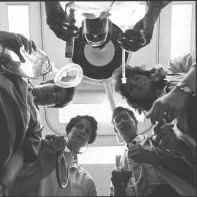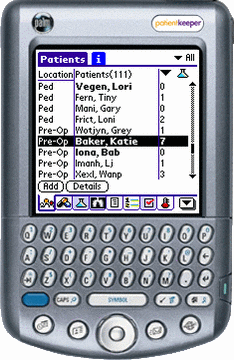|
|

Rapid
Heart Rate
A 40-year-old man
presents to the emergency department with palpitations and
shortness of breath that started a few minutes before his
arrival. The patient states that he was closing his shop
when his heart began to beat rapidly and he had difficulty
catching his breath. His symptoms started suddenly and
continued when paramedics arrived minutes later. They
observed a rapid heart rate on the cardiac monitor and
associated rhythm strips (see Images 1-2). He was
subsequently given adenosine 0.6 mg en route to the
hospital. The patient had a momentary period of asystole,
but his rapid heart rate returned.
On his arrival to the emergency department, the patient
continued to have the sensation that his heart was racing.
He denies having any chest pain, nausea, vomiting,
diaphoresis, light-headedness, or recent illness. He felt
well before this episode. He denies having any symptoms of
infection, such as fever, cough, vomiting, diarrhea,
anorexia, or dysuria. He reports increased stress at work
and is drinking as many as 4 cups of coffee a day. He
reports no notable history of medical conditions except for
a similar episode of a rapid heart rate about 4 years ago;
for this, he was treated with an unknown drug for 2 years.
His family history is significant for a father who died of
a myocardial infarction at 45 years of age. The patient
takes 1 baby aspirin daily. He denies using any
over-the-counter or illicit drugs; however, he smokes 3
packs of cigarettes per week.
On physical examination, the patient is afebrile and has a
heart rate of 165 bpm and a blood pressure of 138/79 mm Hg.
He appears well and is in no acute distress. Findings on
head and neck examination are unremarkable. He has no
jugular venous distention. His heart rate is rapid and
irregular, with an audible S1 and S2 and no gallops, rubs,
or murmurs. His lungs are clear bilaterally. His abdomen is
soft, nontender, and without any masses. He has no
peripheral edema. Results of his laboratory workup,
including a CBC, serum electrolyte and cardiac enzyme
measurements, and a coagulation panel, are all normal. His
chest radiograph is also normal.
An ECG is obtained (see Image 3). What is the diagnosis?

Answer
Atrial
fibrillation (AF) with a rapid ventricular response:
The ECG shows an irregular heart rhythm with no
discernible P waves. Rapid atrial fibrillation (AF)
may be hard to differentiate from a narrow
supraventricular tachycardia (SVT) without close
examination of an ECG. The two conditions can result
in similar symptoms of heart palpitations and
shortness of breath. Patients with rapid AF are not
uncommonly given adenosine to treat presumed SVT, as
in this case. Although this treatment is typically
unsuccessful, the underlying atrial rhythm may be
accurately determined when the heart rate briefly
slows.
The conversion from a normal sinus rhythm to AF may
be due to a number of conditions, including
hyperthyroidism, anemia, infection, ischemic heart
disease, valvular disease, drug intoxication, or use
of stimulants. Increased stress and over consumption
of coffee are likely to have been the instigating
factors in this patient.
AF is a common arrhythmia characterized by chaotic
atrial depolarizations without effective atrial
contractions. This rhythm is often seen with
increasing age, with a male predominance. This
arrhythmia can result in decreased cardiac output
and the formation of atrial thrombi. Many patients
with AF are asymptomatic, and most have recurrent
episodes without knowledge of them.
The American College of Cardiology established a
classification system for AF that is based on its
duration and etiology. The categories are paroxysmal
AF, persistent AF, permanent AF, and lone AF. In
paroxysmal AF, the episodes last less than 1 week.
If they recur, the condition is considered recurrent
paroxysmal AF. In persistent AF, the episodes last
longer than 1 week. In permanent AF, the episode
lasts longer than 1 year without any attempts for
conversion or with attempts that fail. Finally, in
lone AF, no underlying structural cardiac or
pulmonary disease is found. Patients with lone AF
have a low risk of mortality and thromboembolism and
may have paroxysmal, persistent, or permanent AF.
The workup for AF involves careful history taking
and physical examination, laboratory studies
(including a CBC, serum electrolyte tests,
toxicology screening, and thyroid function tests),
ECG, chest radiography, and echocardiography.
The patientís history should include the time of
onset, the frequency of episodes, any associated
symptoms, and any history of treatment for AF.
Laboratory studies may be useful in determining
possible etiologies of AF. The WBC count may help in
finding an underlying infection, and the hemoglobin
concentration may demonstrate anemia. Electrolyte
levels, such as magnesium and potassium levels, may
be abnormal, and an elevated creatinine value may
indicate a renal insufficiency. Certain illicit
drugs can cause a rapid heart rate; therefore, a
toxicology screening may be useful when indicated.
Hyperthyroidism can predispose patients to AF. For
this reason, an evaluation of thyroid function with
measurement of the patientís thyroid-stimulating
hormone (TSH) level is warranted.
AF can be diagnosed when the ECG shows an irregular
rhythm with the absence of P waves. In addition,
examine the patient for any signs of left
ventricular hypertrophy, bundle branch blocks, and
atrioventricular (AV) nodal blocks, as well as for
evidence of cardiac ischemia or previous myocardial
infarction. Chest radiographs may be useful in
evaluating the cardiac silhouette for cardiomegaly
and the lung fields and vasculature for evidence of
airspace disease or pulmonary edema. A transthoracic
echocardiogram can be obtained to identify the size
and motion of the atria, ventricles, and cardiac
valves, and it can reveal pericardial disease.
Transesophageal echocardiography is more sensitive
than transthoracic echocardiography for diagnosing
left atrial thrombus or left atrial appendage
thrombus.
Rate control is important in patients who present
with rapid AF of more than 72 hoursí duration, and
beta blockers (metoprolol or atenolol) or calcium
channel blockers (verapamil or diltiazem) are
recommended in patients who do not have an accessory
pathway. Digoxin and amiodarone are the drugs of
choice for controlling rapid AF in patients with
left ventricular failure and no accessory pathway;
however, digoxin should be loaded over 24 hours.
Therefore, it is unlikely to have a notable effect
in the acute setting. If unable to achieve rate
control with pharmacologic therapy,
catheter-directed AV nodal ablation by a
cardiologist may be considered. Anticoagulation
treatment is also recommended for most patients with
persistent AF, and it is typically achieved with
warfarin (dosed to maintain an international
normalized ratio [INR] of 2.0-3.0). In patients
considered to be at low risk for thromboembolism or
in patients who have a contraindication to the use
of warfarin, aspirin can be given instead.
Conversion to a sinus rhythm may be achieved with
pharmacologic agents or with synchronized external
electrical cardioversion. Conversion should be done
only when the risk of thromboembolism is limited, as
in patients with an onset of symptoms more than 72
hours before presentation, in those who received
anticoagulation for 3 weeks, or in those in whom
transesophageal echocardiographic results rule out a
left atrial thrombus.
After successful cardioversion, anticoagulation
therapy should continue for at least 1 month to
decrease the risk of thromboembolism, which may
occur from the formation of a mural thrombus. After
cardioversion is done and the patientís AF reverts
to a sinus rhythm, use of daily outpatient
antiarrhythmic drugs is not typically recommended,
as these drugs have associated risks; therefore,
they should be taken only when patients have
persistent or frequently recurring symptoms.
Antiarrhythmic drugs that can be used to convert AF
to a normal sinus rhythm include ibutilide,
flecainide, procainamide, and amiodarone. Each has
different risks, success rates, and indications
based on the duration of AF. As a group,
antiarrhythmic drugs can convert 30-60% of cases of
AF to a normal sinus rhythm. Electrical
cardioversion has a higher success rate, converting
75-95% of AFs to normal sinus rhythms. Electrical
cardioversion may be done in a nonemergency setting
after 3 weeks of anticoagulation treatment to
decrease the risk of thromboembolism, or it may be
required on an emergency basis in a hemodynamically
unstable patient. In this situation, AF often has an
acute onset, and the benefits of cardioversion
outweigh the risks of thromboembolism.
The role of cardioversion to manage AF in the
emergency department is an emerging one. Patients
who are at low risk, who are clinically stable, and
who present to the emergency department with
new-onset AF can be treated with chemical or
electrical cardioversion and safely discharged, home
with close follow-up, by a primary physician or
cardiologist.
Images courtesy of ECG
Wave-Maven: Self-Assessment Program for Students and
Clinicians.
References
- Andrews M,
Nelson BP: Atrial fibrillation. Mt Sinai J
Med 2006 Jan; 73(1): 482-92. [MEDLINE
16470327]
- Hood RE,
Shorofsky SR: Management of arrhythmias in the
emergency department. Cardiol Clin 2006
Feb; 24(1): 125-33. [MEDLINE 16326262]
- Lafuente-Lafuente
C, Mouly S, Longas-Tejero MA, et al:
Antiarrhythmic drugs for maintaining sinus
rhythm after cardioversion or atrial
fibrillation: a systematic review of randomized
controlled trials. Arch Intern Med 2006
Apr 10; 166(7): 719-28. [MEDLINE 16606807]
- Pritchett EL:
Management of atrial fibrillation. N Engl J
Med 1992 May 7; 326(19): 1264-71. [MEDLINE
1560803]
- Silverman DI,
Manning WJ: Strategies for cardioversion of
atrial fibrillation--time for change? N Engl
J Med 2001 May 10; 344(19): 1468-70.
[MEDLINE 11346813]
- Tintinalli JE: Emergency
Medicine: A Comprehensive Study Guide. New
York, NY: McGraw-Hill; 2004.
- Ziv O,
Choudhary G: Atrial fibrillation. Prim Care 2005
Dec; 32(4): 1083-107. [MEDLINE 16326228]
|
Link
to further Information on:

For more
information on AF, see the eMedicine articles Atrial
Fibrillation (within the Emergency Medicine specialty)
and Atrial
Fibrillation (within the Internal Medicine specialty).
|
|







 DISCLAIMER:
This website is designed primarily for use by qualified
physicians and other medical professionals. The
information provided here is for educational and
informational purposes only. It is not guaranteed to be
correct and should NOT be considered as a substitute for
the advice of an appropriately qualified expert. In no way
should the information on this site be considered as
offering advice on patient care decisions or establishment
of a patient-physician relationship.
DISCLAIMER:
This website is designed primarily for use by qualified
physicians and other medical professionals. The
information provided here is for educational and
informational purposes only. It is not guaranteed to be
correct and should NOT be considered as a substitute for
the advice of an appropriately qualified expert. In no way
should the information on this site be considered as
offering advice on patient care decisions or establishment
of a patient-physician relationship.